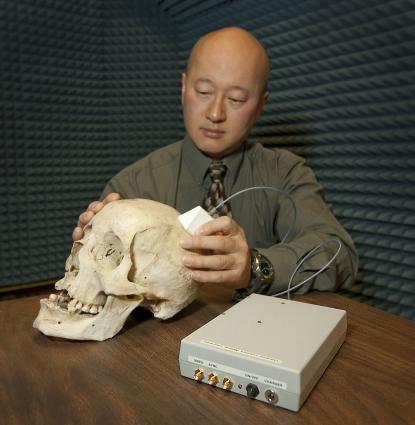A common result of head injury, which leads to complications and sometimes to death, is blood and cerebral fluid pooling between the skull and the brain. Victims of blood pooling, or hematomas, can go for hours or days without presenting clear symptoms of the developing hematoma, yet coma and eventually disability or death can result from the pressure on the brain or brain stem. There is also a ten times greater chance that a head injury victim with a hematoma will die if surgery is delayed by more than 4 hours, but currently expensive, non-portable Computed Tomography (CT) or Magnetic Resonance Imaging (MRI) scans are the diagnostic tools.
Portable intracranial hematoma detectors would offer medical personnel a tool to use immediately at the scene of an injury, in the ER, in urgent care facilities, or in home healthcare settings. Such detectors could help triage accident victims by facilitating the rapid determination of the extent of cranial injuries. Also, the screening by the detector could reduce the need for CT scans, minimizing unnecessary exposure to x-ray radiation. In addition, such detectors could also provide a convenient means to monitor the growth of a hematoma. The use of this device could decrease health care costs and improve patient outcomes associated with testing and treating cranial injuries. Earlier detection could potentially reduce the costs of patient rehabilitation and convalescence and reduce the morbidity resulting from current treatment time delays.
The patented intracranial hematoma detection technology uses Micropower Impulse Radar (MIR). MIR uses short, high frequency electromagnetic pulses to obtain information in a non-invasive manner. Unlike ultrasound and other electromagnetic techniques, MIR can operate well through the skull, which is of great importance for intracerebral as well as epidural and subdural hematomas. The MIR hematoma detector has been studied in both laboratory model and human subject clinical experiments. The results have been reported in the Proceedings of SPIE 2005, Volume 6007.
- Compact, low-cost handheld machine
- Low power (battery operation)
- Non-invasive and safe
- Rapid detection of hematomas
- Greater depth of detection than other techniques (i.e. near infrared/NIR)
The micropower-impulse radar intracranial hematoma detector can be used for:
- Early screening and triage for diagnosis of hemorrhage from head trauma
- On-going patient monitoring
- Neurosurgical procedure preparation
MIR technologies can be used for other medical sensing and imaging needs, such as hemorrhagic stroke detection, vital signs monitoring (i.e. cardiac and respiratory assessment), and human body imaging.
A prototype for handheld detection of intracranial hematomas has been developed. Two patents have been issued: (1) U.S. Patent No. 6,233,479 entitled "Microwave Hematoma Detector" and (2) US Patent No. 7,226,415 entitled "Microwave Hemorrhagic Stroke Detector".


